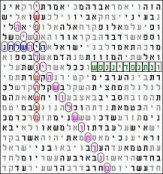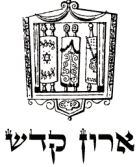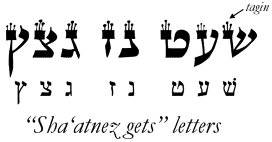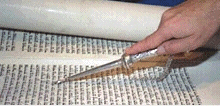|
|
 |
 |
 |
|
The Holy Torah -
|
|
|
The first five books of Moses
|
|
 |
 |
|
The word Torah (תּוֹרָה) comes from the root word yarah meaning "to shoot an arrow" or "to hit the mark." Properly used, the word means "teaching" or "instruction." Teaching is associated with the Holy Spirit, just as God taught Moses what to do and say (Exod. 4:15). And it is clear that Yeshua our Messiah assumed the title of Rabbi and performed much of his ministry as a Teacher (John 1:38).
The Torah is divided into five main sections (79,847 words, 304,805 letters), as follows:
|
|
|
|
|
 |
 |
|
The physical Torah is referred to as the Sefer Torah, or sacred Torah scroll.
|
|
 |
|
|
|
Bereshit
(Genesis)
|

|
The story of the creation of the universe by the God of Israel, and how He chose the Jewish people to be His own covenant people. Bereshit means "in the beginning."
|
|
Shemot
(Exodus)
|

|
The story of the liberation of the Jewish people from their bondage in Egypt. The giving of the Mosaic covenant to Israel. Shemot means "names."
|
|
Vaiyikra
(Leviticus)
|

|
Detailed instructions for the ancient priesthood regarding how Israel might approach God by means of the rituals in the mishkan (tabernacle). Vaiyikra means "And He called."
|
|
Bamidbar
(Numbers)
|

|
The story of how Moses led the wandering Jewish people through the wastelands of Sinai. Bamidbar means "In the wilderness."
|
|
Devarim
(Deuteronomy)
|

|
Renewal of the Mosaic covenant with blessings for obedience and consequences for disobedience. Devarim means "words" and is referred by Jews as the "repetition" of the Torah.
|
|
 |
 |
|
Torah Scroll Facts - How many letters are in the Torah?
|
 |
|
|
|
|
Letters
|
Words
|
Verses
|
Columns
|
Chapters
|
Parshiyot
|
|
Genesis
|
78,064
|
20,512
|
1,534
|
60
|
50
|
12
|
|
Exodus
|
63,529
|
11,723
|
1,209
|
50
|
40
|
11
|
|
Leviticus
|
44,790
|
11,950
|
858
|
38
|
27
|
10
|
|
Numbers
|
63,530
|
16,368
|
1,288
|
52
|
36
|
10
|
|
Deuteronomy
|
54,892
|
14,294
|
955
|
45
|
34
|
11
|
|
Total
|
304,805
|
79,847
|
5,845
|
245
|
187
|
54
|
|
 |
 |
|
- There are 304,805 letters in a Sefer Torah (i.e., Torah Scroll). The most common letter is Yod; the least common is the letter Tet.
- There are over 4,000 laws a sofer (scribe) must know before he starts writing the Sefer Torah. These laws are collectively called soferut.
- Kosher Parchment called klaf must be prepared specifically for a Sefer Torah. A Sefer Torah may require approximately 80 or more skins in all. Kosher quills are used to write the Hebrew calligraphy.
- A Sofer will have at least three to four columns on each piece of parchment - called amudim (from amud - a column). There are 248 amudim in a Sefer Torah and each has 42 lines.
- No letter may touch another one. If only one letter is missing the whole Torah is pasul (not Kosher).
- The average Torah takes 6 months to a year to complete.
|
 |
 |
|
The written Torah of Moses is called the Sefer Torah, or Torah Scroll, and is the most sacred object of Jewish life. The a long scroll is rolled up around two ornate wooden shafts (etz chayim) attached to either end of the scroll.
The Sefer Torah is meticulously handwritten in Hebrew calligraphy with tagin ("crowns") on kosher parchment (this style of writing is known as STA"M).
|
 |
 |
|
Crowning letters
|
 |
 |
|
In some Torah Scrolls, eight Hebrew letters are given special adornment by attaching three "tagin" or crownlets to them. Collectively these letters are sometimes called "sha'atnezgets" letters. Some people have said that these crownlets are the "tittles" referred to by Jesus in Matthew 5:18, although it is unclear that the tagin were in use at the time of the Lord Jesus. It is more likely that the "tittle" refers to the "kots" or "thorn" that projects from a letter.
|
 |
 |
|
Aron Kodesh
|
 |
 |
|
Torah scrolls are kept covered with fabric and are often ornamented with silver crowns on the handles of the scrolls and a silver breastplate on the front - adorned, in fact, like the high priest described in Vaiyikra. Torah scrolls are wound around etz chayim, rollers made of wood and are stored in a special cabinet in the synagogue called an "ark" (an acronym of "Aron Kodesh," meaning "holy cabinet").
|
 |
|
|
|
Torah Shebal Peh
(Oral Torah)
|

|
Talmud. Tradition reports that the two forms of Torah, Torah shebikhtav and Torah shebal peh, have existed side by side ever since the revelation at Har Sinai. The Oral Torah, which was not committed to writing during the centuries preceding the compilation of the Mishnah, was transmitted orally by a chain of sages and carriers of tradition.
|
|
Torah shebikhtav
(Written Torah)
|

|
Written Torah; The writings of Moses; sometimes used synonymously with the 24 books that make up the Tanakh.
|
|
Torat Ha-Nistar
(Hidden Torah)
|

|
The "Hidden" Torah said to trace back to the patriarch Abraham (and even to Adam in the Garden of Eden), though most clearly embodied in sefer ha-Zohar. The hidden Torah is also called "Torat Ha-Sod," the secret Torah.
|
|
 |
 |
|
A Note about Bible Codes...
|
 |
 |
|
While there are some "non-linear" ways of reading the Scriptures that have been developed over the centuries (e.g., gematria, midrash, and so on), a relatively recent approach has been to use computers to attempt to discover "Equidistant Letter Sequences" (sometimes called "Torah codes") to reveal hidden meaning within the pages of the Scriptures and to substantiate its claim to be divinely inspired...

For example, Chuck Missler claims that the word Torah (תּוֹרָה) is found in "Equidistant Letter Sequences" (ELS) of 50 (i.e., 49 spaces between letters) in both Genesis and Exodus. He further claims the word is spelled backwards (i.e., הרות) in both Numbers and Deuteronomy using the same 50 letter sequence. In the Book of Leviticus, this pattern does not appear, though the sacred Name YHVH (יהוה) is discovered using ELS 8 (i.e., 7 spaces between letters). In this way he attempts to argue that the Torah always points to the Name of God, or that the Book of Leviticus is the center of the Torah...
Now while this is somewhat interesting, there are problems with this approach. First of all, while it is true that the word תורה can be found at ELS 50 at the beginning of Genesis and Exodus, and while it is also true that the word הרות appears using ELS 50 in Numbers, the sequence does not appear in Deuteronomy until chapter 5. Moreover, these patterns do not recur throughout the books but simply occur one time (i.e., it is not true that the word "Torah" can be discovered by counting every 50 letters over and over again). Furthermore, the letter combinations for תורה and הרות can be found at 50 ELS in other parts of the Bible, not just in the first five books, so the argument that they uniquely "point" to the Book of Leviticus as the center of the Torah is suspect. In other words, the frequencies of these letter combinations at ELS 50 (or in other increments) is simply too high to make a case that this indicates supernatural codes embedded within the texts. Teachers who promote these sorts of ideas as a "proof" of the Bible's authority are therefore using bad arguments to make rather sensationalized claims. We do not need to look for "Bible Codes" to find the truth, chaverim, we need the Holy Spirit and the desire to live according to the truth...
|
 |
 |
|
The Chumash
|
|
|
 |
 |
|
The Chumash (from the Hebrew word for a fifth, chamesh; plural Chumashim) is a book form (codex) of the Torah, usually subdivided into 54 smaller literary units called parashiot (the name of each parashah comes from a key word of the section). By following the prescribed weekly parashah, synagogues read through the entire Torah every (Jewish) calendar year.
|
|
 |
|
|
|

|
Tanakh Plus. Bilingual Hebrew-English Bible with concordances and amazing Gematria tools. This software program allows you to do research on the Scriptures that more expensive programs cannot do. It includes a complete Hebrew concordance of the Jewish Bible. Only $39.95.
Level: Beginner - Expert. 
|
Click for details
|
|
 |
 |
|
Torah Study Book:
|
|











